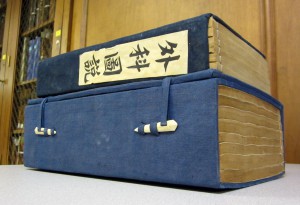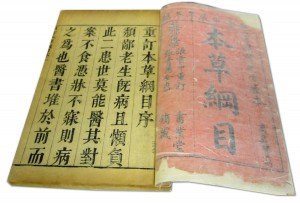 Most of the hidden treasures in the Falk Library collection were contributed by donors. One of these generous people was Lieutenant Colonel J.A. Mendelson, a World War I veteran, who was a member of the United States Military Mission to China, and at one time an assistant professor of Military Science and Tactics at the University of Pittsburgh. During his years in China, Burma, and India, he collected interesting objects related to the cultures of the countries where he served. Many of the swords, daggers, and knives from his collection are housed in the Smithsonian Institute. He also brought home early Chinese medical texts that he gave to Pitt’s School of Medicine’s library during the summers of 1943 and 1944.
Most of the hidden treasures in the Falk Library collection were contributed by donors. One of these generous people was Lieutenant Colonel J.A. Mendelson, a World War I veteran, who was a member of the United States Military Mission to China, and at one time an assistant professor of Military Science and Tactics at the University of Pittsburgh. During his years in China, Burma, and India, he collected interesting objects related to the cultures of the countries where he served. Many of the swords, daggers, and knives from his collection are housed in the Smithsonian Institute. He also brought home early Chinese medical texts that he gave to Pitt’s School of Medicine’s library during the summers of 1943 and 1944.
 These early Chinese books are now housed in Falk Library’s Rare Book Room. The collection includes rare books by Chen Shigong (1617), Dou Hanqing (1717), Li Shizhen (1784), and two 19th century texts by Gao Wenjin (1856) and Chen Huichou (1878) covering the subjects of surgery, blood circulation, blood vessels, Chinese herbal medicine, and acupuncture. One outstanding title is Bencao Gangmu (本草綱目), also known as the Compendium of Materia Medica, written during the Ming Dynasty. This 18th century reprint from the original 1590 edition is regarded as the most complete and comprehensive medical book ever written on the history of traditional Chinese medicine. It lists all of the plants, animals, minerals, and other items that were believed to have medicinal properties. The oldest book in the group, Xin kan Wai ke zheng zong (外科正宗), published in 1617, is a compendium on external diseases in traditional Chinese medicine. According to the Chinese Rare Book Catalog (中國古籍善本書目), there are only four known copies of the book in China. WorldCat, the global catalog of library collections, shows two copies in the United States.
These early Chinese books are now housed in Falk Library’s Rare Book Room. The collection includes rare books by Chen Shigong (1617), Dou Hanqing (1717), Li Shizhen (1784), and two 19th century texts by Gao Wenjin (1856) and Chen Huichou (1878) covering the subjects of surgery, blood circulation, blood vessels, Chinese herbal medicine, and acupuncture. One outstanding title is Bencao Gangmu (本草綱目), also known as the Compendium of Materia Medica, written during the Ming Dynasty. This 18th century reprint from the original 1590 edition is regarded as the most complete and comprehensive medical book ever written on the history of traditional Chinese medicine. It lists all of the plants, animals, minerals, and other items that were believed to have medicinal properties. The oldest book in the group, Xin kan Wai ke zheng zong (外科正宗), published in 1617, is a compendium on external diseases in traditional Chinese medicine. According to the Chinese Rare Book Catalog (中國古籍善本書目), there are only four known copies of the book in China. WorldCat, the global catalog of library collections, shows two copies in the United States.
All of the books are illustrated. They are also examples of traditional woodblock printing. This method was developed in China for printing on silk, rather than paper, and better suited for Chinese character set than movable type. The books are thread-bound, a predominant binding format in traditional Chinese books, and are enclosed in a cloth-covered case which is enforced with wooden boards, and closes with loops and pegs.
The books can be viewed in the Rare Book Room by appointment.
We gratefully acknowledge the help of Zhang Haihui, Chinese Studies Librarian at the University Library System’s East Asian Library, for her guidance and assistance in cataloging these rare Chinese books.
~ Gosia Fort and Liping Song